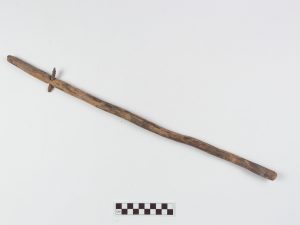Archeologists use a lot of jargon. Some of it is avoidable, but some of it is useful because it helps us talk about unusual materials or items from the past. It can also help us be specific about ancient technologies. Here is a list of archeological terms used on this site that will help you as you read. They are arranged thematically.
Lithic Terms
Lithic
Lithic simply means stone. Archeologists often refer to stone tools and other stone artifacts as lithics. There are two main categories of lithic tools—chipped stone and ground stone. Chipped stone tools are made by hitting a stone, usually chert or novaculite, with another hard material and knocking off flakes. Ground stone tools are made by abrasion. The stone is ground using another stone until it is the desired size and shape.

Projectile Point
A chipped stone tool meant to be attached to a spear, dart, or arrow. This category includes both the earlier spear and dart points as well as smaller, more recent arrow points.
Arrow Point
You often hear projectile points of all types and sizes referred to as “arrowheads” or arrow point, but this is actually incorrect. Only certain kinds of projectile points are true arrow heads or arrow points. Projectile points intended for use with a bow and arrow are small—less than an inch in length. They are chipped stone lithic tools hafted to an arrow shaft.
Spear or Dart Point
A spear or dart point is a larger projectile point attached to a spear or dart. A dart is a projectile meant to be thrown with an atlatl. The word spear is sometimes used interchangeably with the word tart, but sometimes refers to the use of a projectile point hafted to the end of a pole that is meant to be thrust by hand rather than thrown.
Debitage
The stone flakes or chips produced by making a chipped stone tool.

Hafting
The method or material used to attach a stone tool to a handle or projectile, such as an arrow.
Atlatl
An atlatl is a tool used to throw a projectile. In its simplest form it is a stick with a hook at the end, but there are several variations. Atlatls allow you to throw a dart much farther and with greater force. They were a simple and effective technology used for hunting from the Paleoindian period until the invention of the bow and arrow in the Late Woodland period.
Mano and Matate
A mano and matate are used together to process grains, seeds, or nuts. A mano is a ground stone tool held in the hand and used to grind corn or other grains. A matate is the stone slab or basin used to hold the grain being ground with the mano.
Ceramic terms

Temper
Material added to clay before making it into pottery that makes the clay stronger and prevents the finished vessel from shrinking or cracking.
Grog Temper
Baked clay used as temper in pottery. This is usually made up of crushed bits of old pots.
Grit Temper
Small bits of rock and sand used as temper in pottery.
Shell Temper
Bits of crushed shell added to clay. Shell tempering is not used until the beginning of the Mississippi period and is thought to enable to making of lighter and sturdier vessels. The idea is that the laminar or flat shape of the shell pieces aligns in the lay and creates a sturdy structure inside the clay of the vessel.
Other Terms
Paleoethnobotanist
An archeologist who specializes in the study of human use and manipulation of plants in the past. Paleoethnobotanists study plant domestication, and plants used for making textiles in the past.
Zooarcheologist
An archeologist who specializes in studying animal remains in archeological contexts. This can include the use of animals as food as well the use of animal remains, such as bone and antler, to make tools.
Radiocarbon Date/C-14 Date
This is a technique used to give a direct date for an organic material. Carbon-14 is a weakly radioactive isotope of Carbon; also known as radiocarbon, that decays at a known rate. This rate can be used to determine the age of organic materials. This means that this dating technique can only be used for certain materials. It can however be used to date inorganic material given the right context. For example if an inorganic artifact like a stone tool is found in a hearth with charcoal, the charcoal can be dated and we can assume that the point is at least as old as the charcoal it was found with.